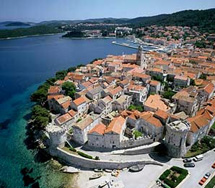
 The 10c century Byzantine historian Emperor Constantine Porphyrogenitus was the first to mention a medieval city on the island of Korcula. He wrote about a "walled city". There are many indications that this city was located on the site of today's old part of Korcula, but no remains of Romanesque architecture from that time have been found. What remains of the old city walls, decorations, and most of all archive documents, show that a walled city existed on this site in the 13th century. It had squares and streets, churches, public buildings and houses.
The 10c century Byzantine historian Emperor Constantine Porphyrogenitus was the first to mention a medieval city on the island of Korcula. He wrote about a "walled city". There are many indications that this city was located on the site of today's old part of Korcula, but no remains of Romanesque architecture from that time have been found. What remains of the old city walls, decorations, and most of all archive documents, show that a walled city existed on this site in the 13th century. It had squares and streets, churches, public buildings and houses.  In the second half of the 14th century stone-carving went through a stage of rapid growth in Korcula, thanks primarily to the needs of Dubrovnik master builders for high quality stone. They came to the stone quarries of Korcula and Vrnik and with the help of local workers dressed stone to be shipped to Dubrovnik. Working alongside those excellent masters the men of Korcula learned the trade and in time became skilled enough to establish their own workshops. After that they began to receive orders for stone from Dubrovnik, and they also worked for the needs of the island. Growing more prosperous, they began to build new houses in Korcula with Gothic decorations.
In the second half of the 14th century stone-carving went through a stage of rapid growth in Korcula, thanks primarily to the needs of Dubrovnik master builders for high quality stone. They came to the stone quarries of Korcula and Vrnik and with the help of local workers dressed stone to be shipped to Dubrovnik. Working alongside those excellent masters the men of Korcula learned the trade and in time became skilled enough to establish their own workshops. After that they began to receive orders for stone from Dubrovnik, and they also worked for the needs of the island. Growing more prosperous, they began to build new houses in Korcula with Gothic decorations. At the beginning of the 16th century houses that had by then not been renewed got Renaissance decorations. This was a time when the city underwent real "polishing": squares and streets were paved, ornate coats-of-arms were placed on buildings, decorative columns added, but the old city nucleus retained its Gothic stamp. In the following 17th and 18th Baroque centuries building and stone-carving declined because economic conditions in Venice deteriorated, which was reflected on areas under Venetian control.
At the beginning of the 16th century houses that had by then not been renewed got Renaissance decorations. This was a time when the city underwent real "polishing": squares and streets were paved, ornate coats-of-arms were placed on buildings, decorative columns added, but the old city nucleus retained its Gothic stamp. In the following 17th and 18th Baroque centuries building and stone-carving declined because economic conditions in Venice deteriorated, which was reflected on areas under Venetian control.  In the 17th century there was no more danger from the Turks so building in Borgo continued and the suburb was enlarged. Soon it became the centre of urban life and work. This was where people traded, where the major craftsmen worked, and very soon other forms of social and public life moved to that part of the town. At that time the number of inhabitants in the old city nucleus decreased: old houses were not repaired, people preferred to build new houses along the seashore near their workshops. Some old houses were reconstructed, but without attention to style so Gothic decorations were removed or destroyed. In this way many valuable buildings and carvings were lost.
In the 17th century there was no more danger from the Turks so building in Borgo continued and the suburb was enlarged. Soon it became the centre of urban life and work. This was where people traded, where the major craftsmen worked, and very soon other forms of social and public life moved to that part of the town. At that time the number of inhabitants in the old city nucleus decreased: old houses were not repaired, people preferred to build new houses along the seashore near their workshops. Some old houses were reconstructed, but without attention to style so Gothic decorations were removed or destroyed. In this way many valuable buildings and carvings were lost.In order to provide you with the best online experience this website uses cookies. Delete cookies
By using our website, you agree to our use of cookies. Learn more
Privacy statement serves us for protection of privacy of our users. You can look at iKorculainfo.com pages for free, without any commitment of revealing your identity or leaving any kind of your private data. In case that you decide to use our services, it's necessary to leave us your personal data, so that we could complete your reservation and to lease asked service. Your personal data remains protected. We assure you that we are collecting only information that we need to complete our procedure of reservation of our service. In that process we are using only information that we receive directly from you.
Use of collected information
We are not going to use collected information for purposes that are not mentioned in this statement. Your personal data, travel agency "Vakance" does not sell, trade, rent or give to third parties, unless it's necessary for the procedure of the realization of selected service. |







